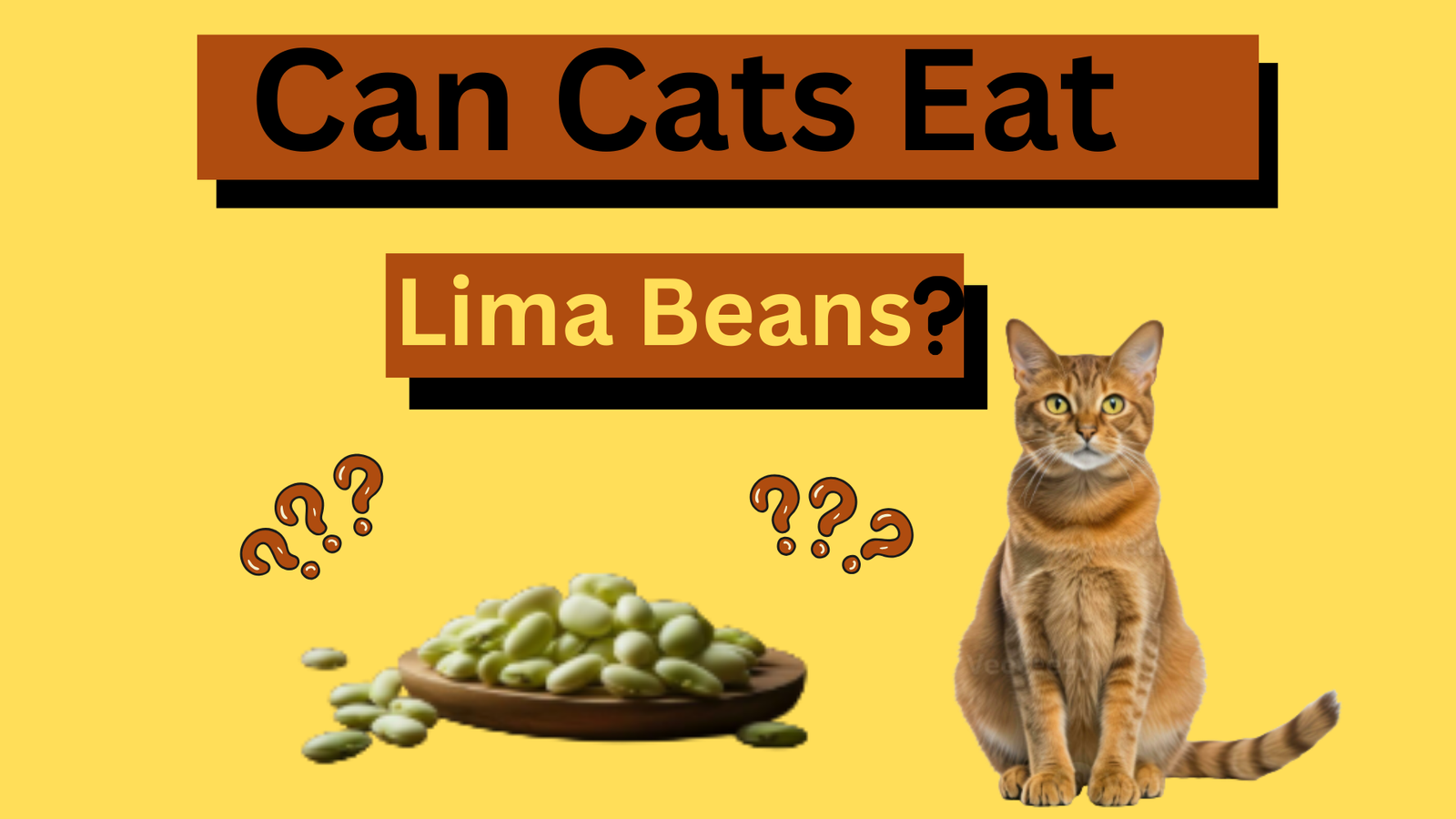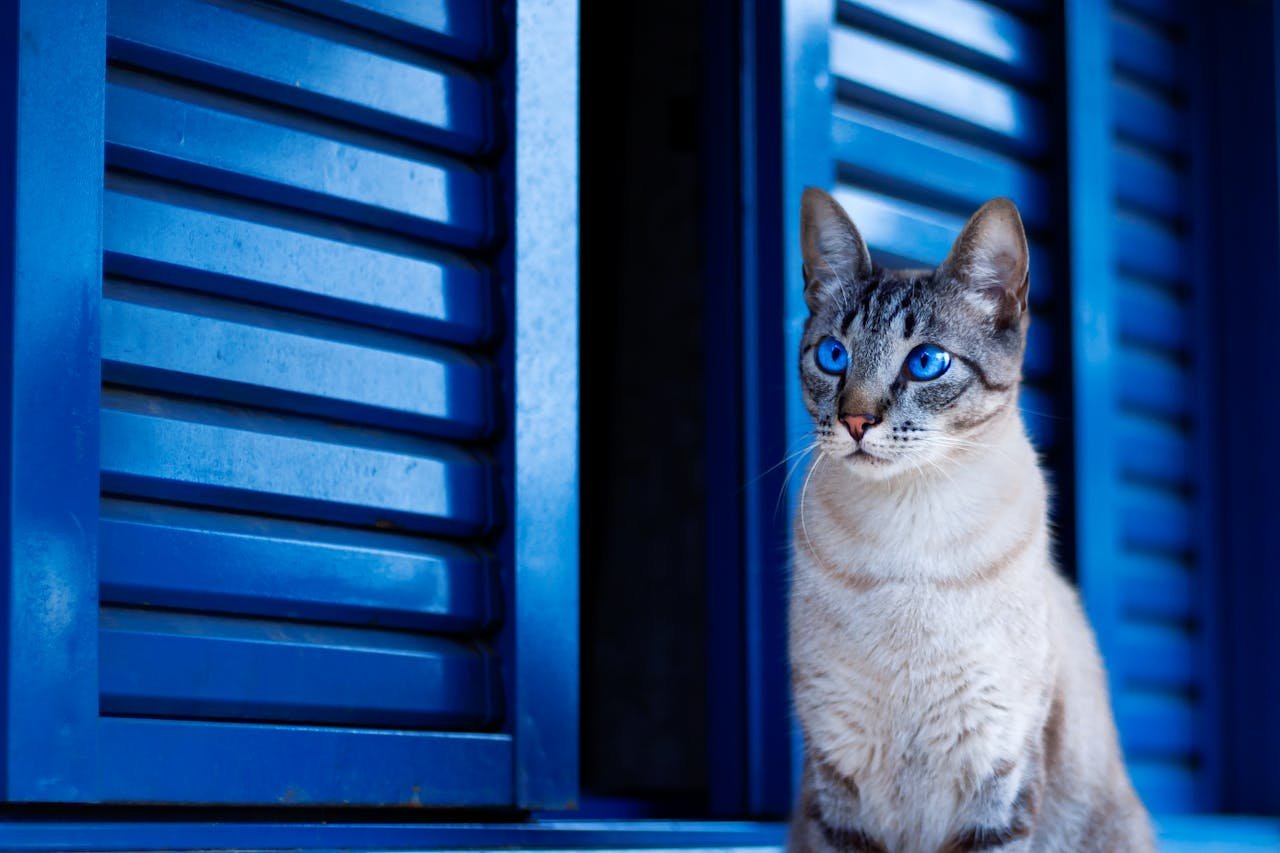Can Cats Eat Lima Beans? Safe Snack or Useless Treat for Your Feline
Cats can eat lima beans in small amounts, but they provide little to no real benefit for feline health. Cooked, plain lima beans are non-toxic and safe as an occasional snack, but they should never replace your cat’s meat-based diet. Since cats are obligate carnivores, their bodies thrive on animal protein—not plant foods like beans. Raw lima beans contain natural toxins, and beans prepared with salt, garlic, or onion can be dangerous. Even safely cooked beans may cause bloating, gas, or diarrhea if fed in excess. In short, a plain cooked lima bean or two won’t harm your cat, but they add no real nutritional value, making them best left as a rare curiosity treat rather than a regular part of your pet’s diet.
What Does It Mean to Eat Lima Beans? A Complete 2025 Guide
Lima beans, also known as butter beans, are a versatile legume enjoyed worldwide for their creamy texture, mild flavor, and nutritional value. Eating lima beans means adding a plant-based source of protein, fiber, vitamins, and minerals to your diet. But beyond being a side dish, these beans hold cultural, culinary, and health significance worth exploring.
Nutritional Profile of Lima Beans
Lima beans are a type of legume also known as butter, wax, or double beans. They are rich in plant-based protein, fiber, and essential nutrients, making them highly nutritious for humans. However, while they contain protein, the kind found in lima beans is not fully digestible for cats.
What Are Lima Beans Made Of?
Lima beans are primarily composed of carbohydrates, plant protein, and dietary fiber, along with small amounts of vitamins and minerals such as iron, magnesium, and B vitamins. They are naturally low in fat and provide a creamy texture that makes them popular in soups, stews, and side dishes for humans.
Do Cats Benefit from Plant-Based Protein?
Cats are obligate carnivores, meaning their bodies are designed to digest and absorb animal-based protein, not plant-based protein. While lima beans do contain protein, cats cannot fully utilize it to meet their dietary needs. The amino acids present in plant protein are incomplete for cats, so feeding lima beans provides minimal nutritional benefit and should never replace meat in their diet.
What Are Lima Beans?
Lima beans are edible seeds of the Phaseolus lunatus plant, native to Central and South America. Their buttery taste and smooth texture make them a staple in many global cuisines. They come in different varieties, such as baby lima beans (smaller, sweeter) and Fordhook lima beans (larger, starchier).
Are Lima Beans Safe for Cats?
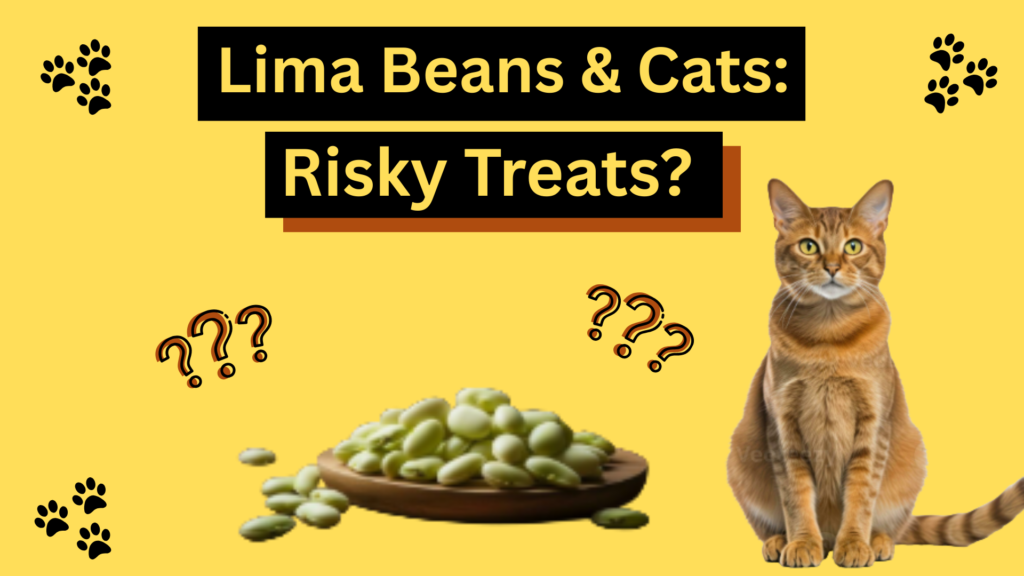
Lima beans are not poisonous to cats, but that does not mean they are completely safe either. Their tendency to cause stomach upset makes them a potential risk for felines. Unlike humans, cats have a very different digestive system that is not built to handle legumes properly. As a result, eating lima beans may cause your cat to feel sick, uncomfortable, or even lead to vomiting. While a small bite might not cause serious harm, the possibility of digestive issues makes lima beans an unnecessary and unsafe choice for your cat’s diet.
Uncooked Lima Beans
However, feeding large portions regularly can be harmful. Raw lima beans contain natural compounds that are unsafe for cats, making them a poor choice for your pet’s diet.
Lectin in Lima Beans
Uncooked or undercooked lima beans contain a toxic compound known as lectin. This substance can upset a cat’s digestive system and may lead to illness. The safest way to reduce lectin levels is by soaking and thoroughly cooking the beans, which breaks down these compounds and makes them less risky for consumption.
Additional Ingredients
Lima beans prepared for humans are often seasoned with ingredients that are dangerous for cats. Common additives such as garlic and onions are highly toxic to felines, while excess salt, pepper, and heavy spices can be harsh on their digestive systems. Even if the beans themselves are safe in small amounts, the added seasonings make them unsuitable for cats.
Can Cats Benefit from Eating Lima Beans?\\
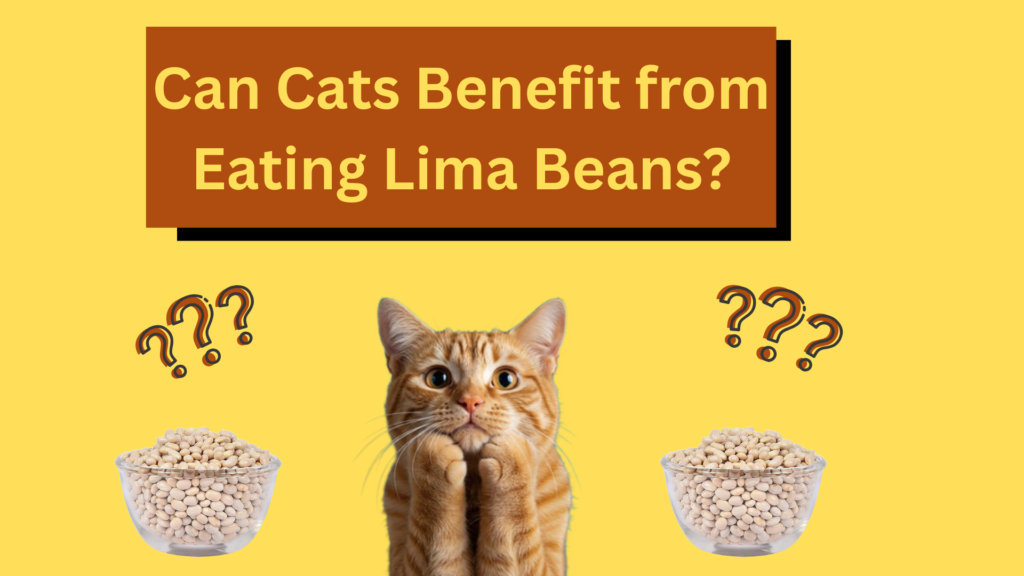
A Supplemental Source of Protein
- Contains plant-based protein that breaks down into amino acids.
- Amino acids help cats build and repair muscles, skin, fur, and nails.
- Not a replacement for animal protein, but offers a small complementary boost.
Rich in Dietary Fiber
- Cats don’t need much fiber, but tiny amounts can support digestion.
- Fiber adds bulk to stool and helps keep the digestive system moving.
- May help cats with occasional mild constipation.
Helps Regulate Bowel Movements
- Fiber absorbs water and balances stool consistency.
- It can soften stool in constipation or firm it during mild diarrhea.
- Supports cats with occasional sensitive digestion.
Provides a Natural Source of Bulk Similar to a Prey Diet
- Wild cats consume whole prey (bones, hair, connective tissue) for gut health.
- Domestic cats usually lack this natural bulk in their diet.
- Plant fibers in lima beans mimic this effect by adding texture and bulk.
What Are the Risks of Feeding Cats Lima Beans?
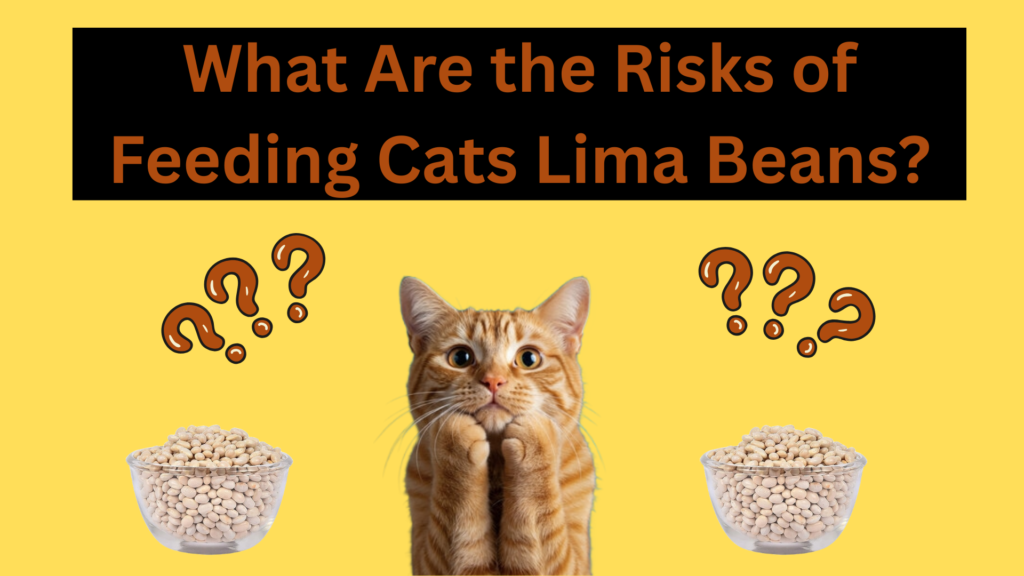
Cats’ digestive systems are not designed to process legumes, and offering lima beans too often or in large amounts can create more harm than good. Here are the main risks every cat owner should know:
Digestive Discomfort
Cats lack the enzymes required to break down plant starches effectively. Because of this, eating lima beans can lead to stomach upset, bloating, or abdominal discomfort in many felines.
Excessive Gas and Flatulence
Legumes, including lima beans, often cause gas buildup. For cats with sensitive stomachs, this can result in noticeable discomfort, restlessness, or even a refusal to eat.
Vomiting or Diarrhea
Since lima beans are not easily digestible for cats, some may vomit shortly after eating them, while others might experience diarrhea or loose stools.
Risk of Fiber Overload
A little fiber can support digestion, but too much may do the opposite. Excessive fiber from lima beans can contribute to constipation, especially if the cat is not drinking enough water.
Low Nutritional Value for Cats
Although lima beans contain protein, it is plant-based and not fully digestible for felines. Cats need animal-based protein and taurine, which legumes cannot provide, making lima beans nutritionally inadequate.
Potential Choking Hazard
Whole or undercooked lima beans may be too firm and difficult for cats to chew, creating a potential choking hazard if swallowed in large pieces.
How to Safely Offer Lima Beans (If You Must)
Even though lima beans are not essential for cats, some owners may wish to offer them as an occasional treat. If you decide to do so, proper preparation and moderation are crucial to minimize any risks.
Proper Cooking and Preparation
- Always cook lima beans thoroughly – Raw or undercooked beans contain lectin, a compound that is toxic to cats. Soaking and boiling the beans completely breaks down this substance, making them safer for consumption.
- Serve plain and unseasoned – Avoid adding salt, garlic, onions, or other spices, as these are harmful to cats. Plain, fully cooked beans are the only safe option.
- Mash or cut into small pieces – This prevents choking and makes it easier for your cat to chew and digest.
Serving Size and Moderation
- Offer very small portions – One or two beans at a time is sufficient for a cat to explore the taste without risking digestive upset.
- Use as an occasional treat – Lima beans should never replace meat or regular cat food in your cat’s diet.
- Monitor your cat’s response – Watch for signs of stomach upset, bloating, or gas after trying beans for the first time. If any symptoms appear, discontinue immediately.
Better Alternatives to Lima Beans for Cats
Instead of relying on lima beans, consider safer and more nutritious options that support your cat’s natural dietary needs.
Cat-Safe Vegetables
- Cooked pumpkin or zucchini – Low in calories, high in fiber, and gentle on the digestive system.
- Peas – Provide a small amount of fiber and nutrients without causing stomach upset.
- Carrots – Softened through steaming or boiling, carrots can be offered in tiny pieces as a crunchy treat.
High-Protein Animal-Based Snacks
- Cooked chicken or turkey – Excellent sources of complete protein and essential amino acids.
- Boiled eggs – Offer a small portion for added protein and healthy fats.
- Commercial meat-based cat treats – Specifically formulated to meet cats’ nutritional requirements.
Related Post: Can Cats Eat Cheez Its Without Harm? Truth You Need!
Final Thoughts: Should Cats Eat Lima Beans?
Lima beans are not toxic, but they are far from a necessary or ideal food for cats. While they contain protein and fiber, the nutrients they provide are incomplete for obligate carnivores and can sometimes cause digestive issues. If you choose to offer lima beans, ensure they are fully cooked, plain, and given in very small amounts, strictly as an occasional treat.
For your cat’s long-term health and well-being, the best nutrition always comes from high-quality animal protein and cat-safe vegetables. Beans should never replace meat in a cat’s diet, and careful observation is key if your feline tries them for the first time.
FAQs About Cats and Lima Beans
Can cats eat lima beans safely?
Yes, cats can eat small, fully cooked, plain lima beans occasionally, but they are not necessary for their diet.
Are raw lima beans harmful to cats?
Yes, raw or undercooked lima beans contain lectin, a toxic compound. Always cook beans thoroughly before offering them.
How often can I give my cat lima beans?
Lima beans should only be offered rarely, in tiny portions. They are a treat, not a meal replacement.
What are the benefits of lima beans for cats?
In very small amounts, lima beans provide fiber for digestion and a minor boost of plant-based protein, but these benefits are limited compared to meat.
What are the risks of feeding lima beans to cats?
Potential risks include digestive upset, gas, bloating, diarrhea, and low nutritional value if given too frequently or in large amounts.
Are there better alternatives to lima beans for cats?
Yes, cooked chicken, turkey, boiled eggs, and cat-safe vegetables such as pumpkin or peas are far more beneficial and easier to digest.
For More Visits: SiameseMania
Also Read: Can Cats Eat Rambutan? A Pet Parent’s Safety Guide
